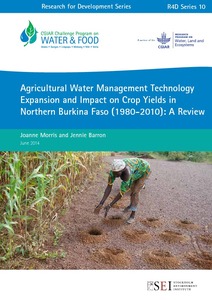Resource information
Agricultural water management (AWM) interventions, such as soil and water conservation or small-scale irrigation around small-scale water reservoirs, have repeatedly shown benefits to yields, soil fertility and water availability – at the field and experimental farm scale. It is assumed that these benefits will result in better and more sustainable livelihoods. However, there has been little published evidence of such wide-scale beneficial impacts. This study synthesizes evidence, at the sub-national scale of region, across northern Burkina Faso, of adoption rates of AWM interventions compared with indicators of impact on livelihoods in the form of yield changes, poverty indices and food security. Using several independent sources (national statistics and independent reports and peer papers), the study has found multiple pieces of evidence that since the 1990s provincial adoption rates have been a minimum of 10-20% in provinces with >700 mm of rainfall and up to 40% in several other provinces. Over the same time period, regional cereal yields have had similar rates of increase (ca 3%) as the adoption of soil water conservation and small reservoir expansion. The link to poverty and food security is less clear, highlighting that at the provincial and regional scale much more data is needed to establish the causality between AWM adoption, crop yields and poverty/food security impacts. Multiple methods exist for developing knowledge on provincial and regional level AWM technology adoption and livelihood impacts, but such information is not readily available in the public domain for decision making, research or policy. The methods for measuring indicators of development impact should be explored further. It is particularly critical to capture indicators linking field-scale improvements to the broader socioeconomic and institutional pro-poor development agenda of rural livelihood systems in semi-arid West Africa.


